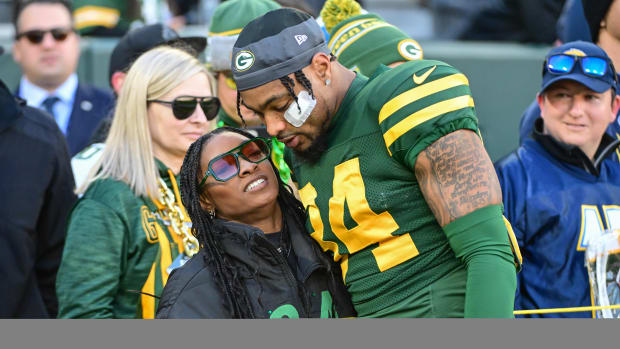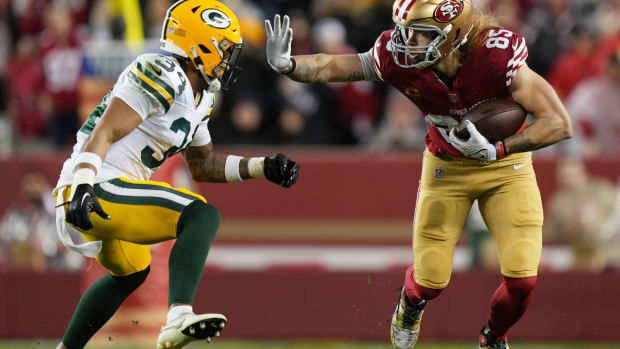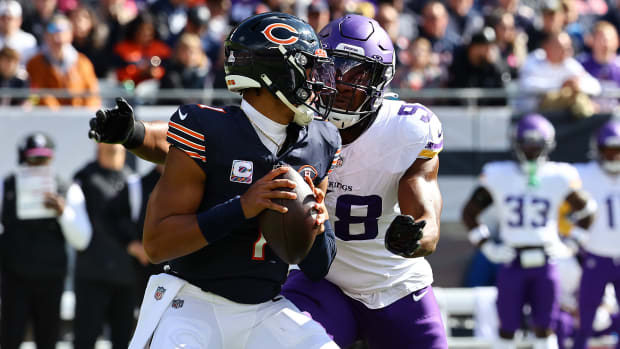Expanding Bears Offensive Horizons
Free agency bolstered Bears depth and skills in some areas.
What it really did that can't be put down on paper in terms of actual hard numbers yet is expand their ability to attack and defend in ways they couldn't.
The roster in 2022 lacked overall athletic ability and couldn't take advantage of some of the ways the offense Luke Getsy brought to Chicago can operate. They've also added pieces they didn't have that let Getsy expand this offense beyond parameters he set for it last year.
Here's what the Bears can do better on offense after free agency's first wave. If they ever get their right tackle problem solved, the sky is the limit.
1. Ground-and-Pound
People still will put the tailback deep in the I-formation behind a fullback and pound it at opponents on occasion. It works effectively when used properly. The 49ers use it well with wide-zone blocking in their running attack at times.
Signing D'Onte Foreman gives the Bears something they haven't had since they traded Jordan Howard. Foreman is a downhill type of runner with good speed and size and could exploit that formation with a blocking fullback.
Matt Nagy didn't want to run I-formation. He wanted to express himself through his offense. Primal caveman football didn't appeal to him, even if his team would have benefited from it at times both in Chicago and when he was offensive coordinator for the Chiefs during the 2017 playoffs.
The Bears drafted David Montgomery because he's an ideal RPO back and inside zone runner. He can make a first tackler miss, then exploit the gap created by doing it. Or he can hit the tight cutback off the blocks by tackles or tight ends and break initial tackle attempts.
The wide zone favors a back who can follow the blocking flow, see the gap and explode to the next level. Montgomery seemed uncomfortable at getting to and finding the hole on stretch plays, then exploding to the next level.
The Bears brought in Luke Steckel from the Tennessee Titans, a running game analyst and assistant, as their offensive line assistant. They have the Titans fullback, Khari Blasingame. They now have former Titans guard Nate Davis and also Foreman, who was running back Derrick Henry's backup and entirely effective smashing defenses last year after replacing Christian McCaffrey in Carolina.
It would be a misnomer to call Foreman only a one-cut type. He is sort of a cruiser who anticipates tacklers approaching and makes small shifts in advance while maintaining downhill speed. He's not a stand-at-the-line dancer or a second-and-third-effort guy like Montgomery.
Khalil Herbert can do a little of both the RPO and the downhill stuff.
So if Getsy likes, he can stuff it down an opponent's throat now the way the Colts liked to do in the past with Jonathan Taylor. No doubt Matt Eberflus enjoyed seeing this aspect of football while he was Colts defensive coordinator.
2. Bootleg Action
It's easier to run pure bootleg action out of the I-formation like the Vikings do. This gets a quarterback out in the open to run himself or throw all over the field better than an RPO/zone read does, although zone read does have its merits.
Defensive ends were trying different techniques last year to stop both the back in the RPO and Fields, and they had some success at this. Put a powerful back running downhill to take the handoff and defensive ends lose time to react. They need to crash in a hurry to get to that back. There's no "surfing" or waiting for the QB to pull the ball and run. There isn't time.
Since the handoff occurs farther back, so, too, does the fake. As a result, there is more open backfield space for a running quarterback to maneuver if the ends have read the bootleg fake correctly.
Stopping Justin Fields by using the mesh tactic opponents used last year isn't as effective against the bootleg fake from an I as against the RPO/zone read.
3. Play-Action
The Bears always had a love-hate relationship with this under Nagy. He'd talk about wanting to do it more, then didn't.
The RPO is a form of play-action but it limits routes for a receiver to get open unless the line is top quality at blocking it. Obviously the Bears line wasn't capable of blocking this. The routes that pop open most in RPO are intermediate distance over the middle or shorter over the middle.
With speed like Velus Jones Jr., DJ Moore, Chase Claypool and Darnell Mooney have, the deep routes on play-action should come open more often than in the past. All four receivers ran 4.42 in the 40 or better. Using the play-action fake but not necessarily in RPO gives them time to get well downfield.
4. Catch-and-Run
Even more than the play-action deep passing, talent the Bears now have can open up the offense for more catch and run. The Bears hoped to improve their ability for yards after the catch last year because they tied for last in the league in 2021. Getsy came to the Bears from an offense that had been top 10 in yards after the catch for three straight years with Matt LaFleur as Green Bay coach.
Instead, the Bears ranked last in the league at 1,149 yards after the catch in 2022. Some of this has to do with Fields not taking the quick throw and looking for deeper passes too much. Some has to do with lack of receivers who could gain yards on short passes after the catch. Some came from the poor offensive line getting the quarterback clobbered first.
These problems, combined with the season-ending injury to Darnell Mooney that cost him 5+ games, and limited their YAC. Mooney is very adept at slipping tackles despite his lack of size.
Now, they have DJ Moore, who was 12th in the NFL at YAC in 2021 and 15th in 2019 despite it being a stat running backs usually dominate. Moore can catch the short pass and roll off bigger chunks of yards.
5. Wide Receiver Runs
One thing Getsy brought in that wide-zone scheme was the wide receiver run as a counter play. It might be end-around, or even jet sweeps, but the receivers were more involved as runners.
Bears wide receivers had 20 attempts for 199 yards last year. In 2021 they had 13 for 64. But 20 attempts in 17 games isn't adequate when they have big, fast receivers who are capable of breaking tackles.
They'd like to get where the 49ers were. San Francisco ran wide receivers 49 times and gained 342 yards.
Now, the Bears bring in Moore, who has been more involved as a runner at 6-foot, 210 pounds. He has run 39 times for 335 yards and would be an alternative type of back, even if the run is an end-around or jet sweep. In fact, some scouting reports of Moore during free agency indicated he was a "Deebo Samuel type." He's 5 pounds lighter but the same height.
Expect to see more Jones and Moore runs, if not some from Claypool who, at 6-3, 238 pounds, is enough to frighten any tackler when running full speed up the field.
6. An Alternate Tight End
Whether it's a red zone target or one on on third down, the Bears now have someone else they can throw it to at a tight end position besides Cole Kmet. They made him do everything last year when he led the team in catches (50), receiving yards (544) and touchdown catches (7). Ryan Griffin was on the field for 159 plays, got targeted exactly eight times, caught four passes and had 26 yards with one one first down. He didn't score a TD, but did get open for one once when Fields overthrew him. Trevon Wesco got in for even more plays, 181, and had four targets, two catches and 26 yards with a first down. No touchdowns here, of course. T
he trend in the NFL toward 12- and 13- personnel packages was wasted in Chicago. This year at least Tonyan gives them 12-personnel capability that they haven't had.
Twitter: BearDigest@BearsOnMaven





